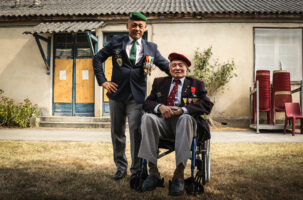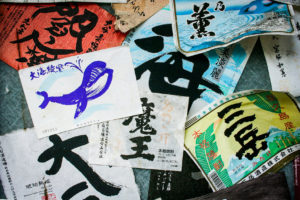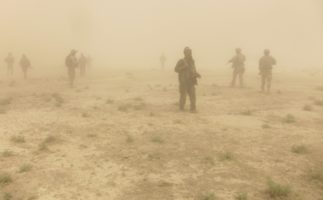On the edge of a small Estonian city, derelict factory buildings sprawl over nearly 80 acres along a stretch of a fast-flowing river. The Kreenholm textile factory once thrummed with activity. Now, in the former administrators’ canteen on the fourth floor of one of the main buildings, only a few relics of the factory’s glory days remain. Apart from an upturned counter, the dining furniture has long been removed, but the pyramid-pattern wooden paneling is preserved on the ceiling, and the back wall is covered with primary-color pop art.
My interpreter, Denis, says the food in the main canteen was one of the best things about working at Kreenholm, according to former employees. But there is no longer any diners’ din, rattling cutlery, or garlicky aromas — just a wooden clock on the wall, stopped at 9:55, and a broken chair.
Natalia Kapaeva is wrapped against the December chill in a yellow coat and white woolen hat, her cheeks wrinkled in an anxious smile. She worked here as a textile designer. I’ve been told she is nervous about coming here today. Though she has agreed to reminisce, she is wary of the emotions that might be stirred by returning to this place.
This enormous textile factory was once the bustling, cacophonous hive for thousands of employees. Since my first visit in April 2023, I’ve felt compelled to tell its story — to fill its ghostly vacancy and bring it to life, to hear its stories on the site itself. This is now my fourth visit, Natalia is the fourth former employee I have met, and her anguish at attending the now cavernous, deserted shell is palpable. Over the course of my previous visits, however, it has also become apparent to me that there are other sources of anguish for Natalia and her fellow former employees — and for the remaining 56,000 residents of Narva, Estonia.

Once upon a time, the Kreenholm textile factory was the largest factory in the Russian Empire. Today, its abandoned structures sit on the border with Russia, awaiting a new — or the repetition of a historic — fate. Photo: Tim Bird.
~~
From the factory’s tallest north-facing towers, the Russian town of Ivangorod is clearly visible on the opposite side of the Narva River. A bridge connects the two countries, which are close enough for fishermen on opposite banks to call out to each other. There used to be a lot of movement here: Narva’s population is more than 90 percent Russian-speaking. Natalia is one of many Narva residents who were born on the Russian side — in her case, in Leningrad, now St. Petersburg — in an era when Estonia was an unwilling component state of the Soviet Union. But once busy, the bridge now sees only a trickle of scurrying pedestrians, as traffic between Russia and Estonia has slowed since February 2022, when Russia invaded Ukraine.
On either side of the river, two medieval castles loom. The red, blue, and white stripes of the Russian flag fly from a turret on the northern bank, flapping over parapets concealed in shadow at night. The fortress on the Estonian side stands in contrast, brightly illuminated.

The two opposing fortresses on the Narva River: one cast in light, one obscured in shadow. Photo: Tim Bird.
~~
Before my first visit, I had never heard of Kreenholm, but on a trip to Narva with other British travel writers, our hosts spoke of a giant abandoned industrial site that was open only by appointment. It was “amazing” and “extraordinary,” they said. I wondered how these superlatives might apply to an abandoned factory. There are crumbling industrial buildings littering the world, not least in places formerly under Soviet rule. What was so especially enchanting about this one?
From the first moment of that first visit, I was in awe — of the factory’s palatial scale, of the remnants of its former industrial glory. Colored layers of paint peeled back from the walls and from rows of iron pillars that used to bear the massive weight of machinery. In a hall that once echoed with the rattle and clank of spinning machines, the silence was now punctuated with the occasional flap of cooing pigeons. The peeling paint revealed pastel pinks and soft greens, as if its initial design had taken into account the abstract beauty of eventual decay. I wandered from floor to silent floor, imagining the rhythms of the machinery and specks of cotton caught in slanted sunlight.

For writer and photographer Tim Bird, it was impossible to wander the abandoned halls of the Kreenholm factory and not imagine what it might have been like when thousands of people came to work here each day. Photo: Tim Bird.
I crossed a bridge, walking beneath gothic arches reinforced with iron frames, from the six-story main building on the riverbank to a second large brick building on Kreenholm Island — the Estonian river island that gave the factory its name.
The sheer scale of the premises accounted for much of my intrigue — the two main buildings and several annexes house 100,000 square meters of floor space. So too did its ambient empty melancholy, its sad sense of former cacophony and chaotic purpose.
I was also instantly aware of the factory’s location on the edge of the former Tsarist and Soviet empires, from which its diverse workforce was gathered. This is a frontier loaded with historical conflict, and Narva’s proximity to its powerful former ruler bestows on it a particular vulnerability.
~~

Long before rail connected Narva to Tallinn, the Kreenholm factory received supplies from as far away as South America via the Narva River. The river currently runs along the border between Estonia and Russia before emptying into the Baltic Sea. Photo: Tim Bird.
The cotton mills of the Kreenholm Manufacturing Company, founded by the German industrialist Ludwig Knoop in 1857, comprised the biggest factory in what was then the Tsarist Russian Empire. Knoop chose the site for the ready source of power and water provided by the river rapids. Its significance was underlined by the completion of the railway line between the imperial capital of St. Petersburg and Narva in 1870. By 1914, the factory produced more than 17 thousand tonnes of yarn and more than 70 million meters of fabric annually, accounting for at least 10 percent of the empire’s cotton textile production. The factory facilities followed a contemporary British model, whereby separate zones were developed for housing, schools, and medical care in addition to the industrial buildings.
The nations and regions of the Baltic shores have changed hands with bewildering regularity over the centuries, with Swedes and Germans playing major roles at various stages of Narva’s complicated history. Although the dominant, and previously resident, neighbor has always been Russia, other influences have left their mark.
Follow the river a few kilometers toward the sea along its western bank and you eventually arrive at the shaded cemetery for German troops who perished here in their unsuccessful defense of Narva against Soviet forces toward the end of World War II. The inconspicuous but ample cemetery, with its somber squat stone crosses and memorial monoliths, does not figure highly on the Narva tourist trail. After years of Nazi occupation, Soviets leveled the city with air raids in March of 1944 and blamed the Germans who retreated that same year. Whatever their feelings about their neighbor’s current leadership, some of Narva’s more senior population still regard the victorious Soviets as liberators.
~~
There are crumbling industrial buildings littering the world… What was so especially enchanting about this one?
Back in the administrator’s office, Natalia gradually relaxes as she describes her memories of Kreenholm life. Denis translates from Russian, while his sister Diana looks on. Natalia has lived here since 1975, when she started work at Kreenholm. I anticipate descriptions of stern oppression, but she recalls fulfillment during her employment, which lasted until 1993:
“There were two art workshops. One was at the finishing factory, which produced printed fabrics, and the other was at the Georgievsky weaving factory, where they made tapestry fabric, towels, and blankets. In our workshop, depending on the time, there were seven or eight people. We were all very close, and had a great understanding with one another,” Natalia says.
But Kreenholm was also special for what happened outside of working hours.
“Once a week, we had a free day. We could visit exhibitions and libraries, to see new exhibitions in museums. This was very important and necessary. It was truly fascinating.”
Natalia’s eyes drift and seem to cloud at this convivial memory. I imagine her exchanging small talk with her workmates, laughing and gossiping about their supervisors.
“My husband’s family has lived here in the Narva River region for approximately 200 years. Both my husband and I know a lot about this area because when we got married, his father, as well as his father’s sisters and brothers, were still alive. They told us a lot about what life was like before the Second World War, during the war, and how villages were flooded to create what is now the Narva Reservoir. It’s a fascinating history.”

Images of the factory at work loom large in the empty rooms of Kreenholm, where the art of decay is on full display. Photo: Tim Bird.
~~
In 1991, as the Soviet Union was collapsing, Estonia reclaimed its independence, which had originally lasted from 1918 until 1940. The Soviets briefly occupied after that, then Nazi Germany shoved them aside and remained until 1944. During the years of the second Soviet occupation from 1944 to 1991, people were brought from all over the USSR to work at the factory and made their permanent homes in Narva. As many as 11,000 people of 40 nationalities were employed at Kreenholm in the mid-1980s, when the factory was granted the then-unusual right to export its goods outside the Soviet Union.
When Estonia regained its independence following the second Soviet occupation, the factory had to adapt to the global market economy. It struggled to do so. Kreenholm was privatized in 1995 and acquired by a Swedish textile company. Over the next 15 years, profits gradually declined, and workers were laid off until only 500 employees were left. In 2010, the company declared bankruptcy. No comparable source of employment has been available to Narva’s residents since.
Kreenholm’s future is uncertain. The broad courtyards host summer concerts, but hopes of converting the complex into a giant permanent arts center have been dashed by the reluctance of private investors to back a remote project so close to the Russian border at a time of such tension. Other ideas have been aired. Denis the translator, for example, described his ambitious idea of converting the premises into a vast casino, a mini-Las Vegas welcoming gamblers from both sides of the border in an imagined peaceful future.

Artwork, like this light installation, peppers the abandoned factory, whose future is still uncertain. Some hope to make it an art center, others have different ideas. Photo: Tim Bird.
~~
An elderly babushka trudges along the path across the river, struggling with a bag of groceries in the direction of the upstream hydro-electric plant. Estonia is not at war with Russia, and mundane routines continue, but the vision of the old lady seems so much sadder to me knowing that residents on both sides of the border have so much in common in terms of culture and language.
After a more cooperative but short-lived post-Soviet period, Estonia’s tensions with its eastern neighbor have reignited. With families divided on either side of the border, another layer in the troubled and bewildering fabric of the region is being woven. Although Natalia’s memories are of a bright, enlightened community of employment, Kreenholm is a landmark of a former imperial era when small countries were bullied and occupied by their much larger neighbors.
In possession of the bewildering facts of its past, I’ve wandered through Kreenholm’s derelict courtyards and abandoned cathedrals of industry, sensing the weight of history, the regional and global ebbs and flows, the triumphs and defeats. With renewed conflict, there’s a stark possibility that history might repeat itself.
~~
As if its initial design had taken into account the abstract beauty of eventual decay.
In January 2024, I take the train from the Estonian capital, Tallinn, for the 2.5-hour ride east to Narva for a second visit. The recent snow has melted and then frozen again, and I skid and stumble on the short walk from the station to the Narva Hotel. This is the end of the line, the tense edge of the NATO alliance, and I feel the guilty, visceral thrill of being here — guilty, because the locals at this strained border would probably prefer, and certainly deserve, a less confrontational existence.
At the Kreenholm gate the next morning, I meet the guide hired for me by the Narva Museum. He is an enthusiastic, burly man, dressed in a long white coat. Later, he tells me he sings in a rock band and secures visas to travel to St. Petersburg for soccer matches to support his team, Zenit.
Like all the Russian speakers that I talk to in Narva, Ivan (which is a pseudonym) identifies with Russian culture but not with its current leadership. “I am pro-Russian, but not pro-Putin,” he says.
Ivan tells me he loves to guide visitors at Kreenholm, displaying a boyish enthusiasm for guiding me through its darker corners and stairways. In his thirties, he is too young to remember the factory at its productive zenith, but he harbors the same affectionate nostalgia as Narva’s older residents for this mammoth of a factory.
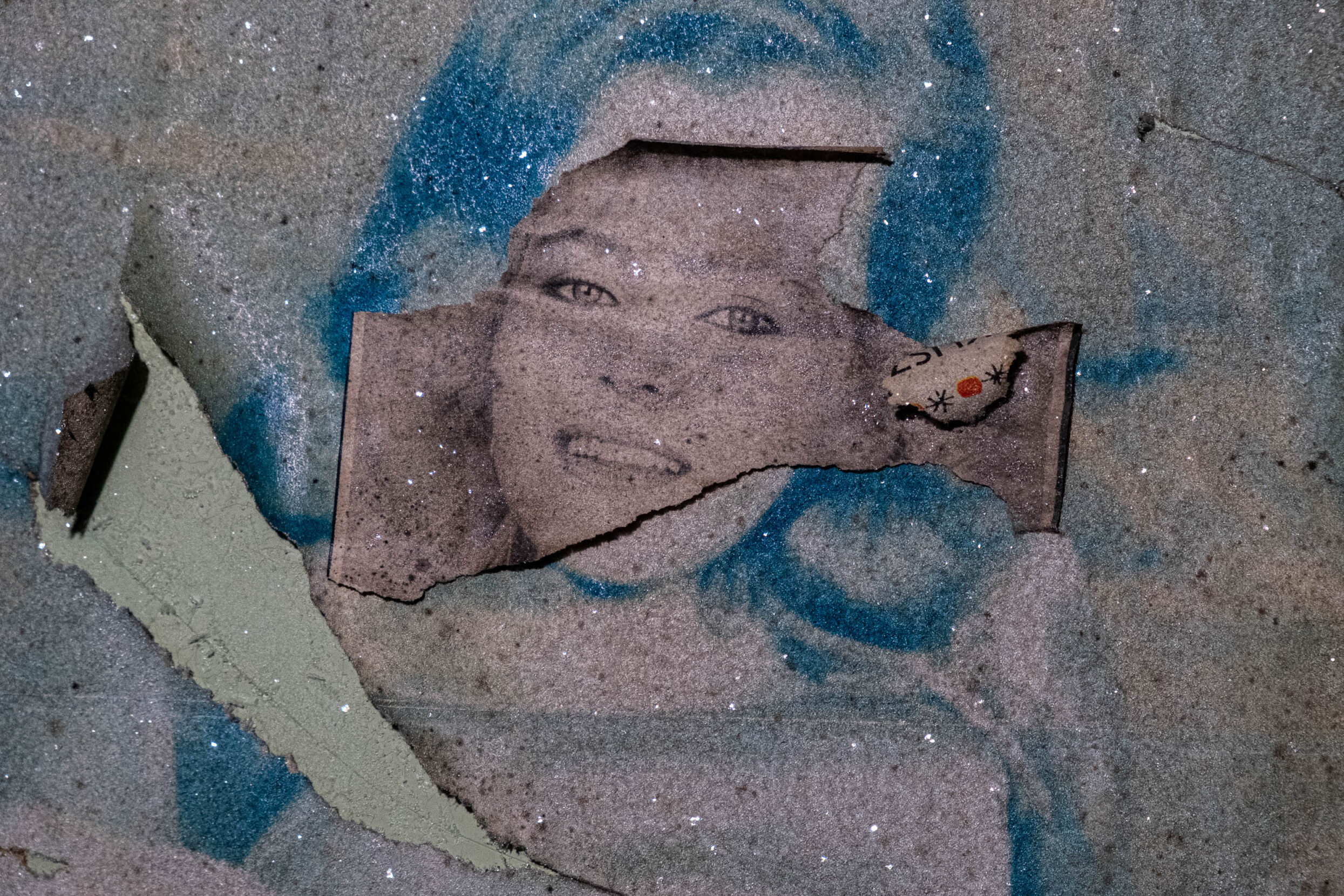
The eerie images of abandoned industry are on full display in Kreenholm. Here, the poster of a woman peels from a wall, her face sparkling with ice crystals. Photo: Tim Bird.
He takes me to unexpected corners of the complex. We linger in a gloomy room where workers used to relax between shifts. There are faded photos of female movie stars on the wall, and their faces sparkle with frost as I shine a flashlight. A similar shimmer coats a multicolored display of bottle labels — vodkas and beers from Estonia, Russia, and beyond. Thick, intricate hoarfrost patterns sparkle on the windows. The cold air is whirling. I shoot happily away with my camera, with the delight of a child in a toy shop.
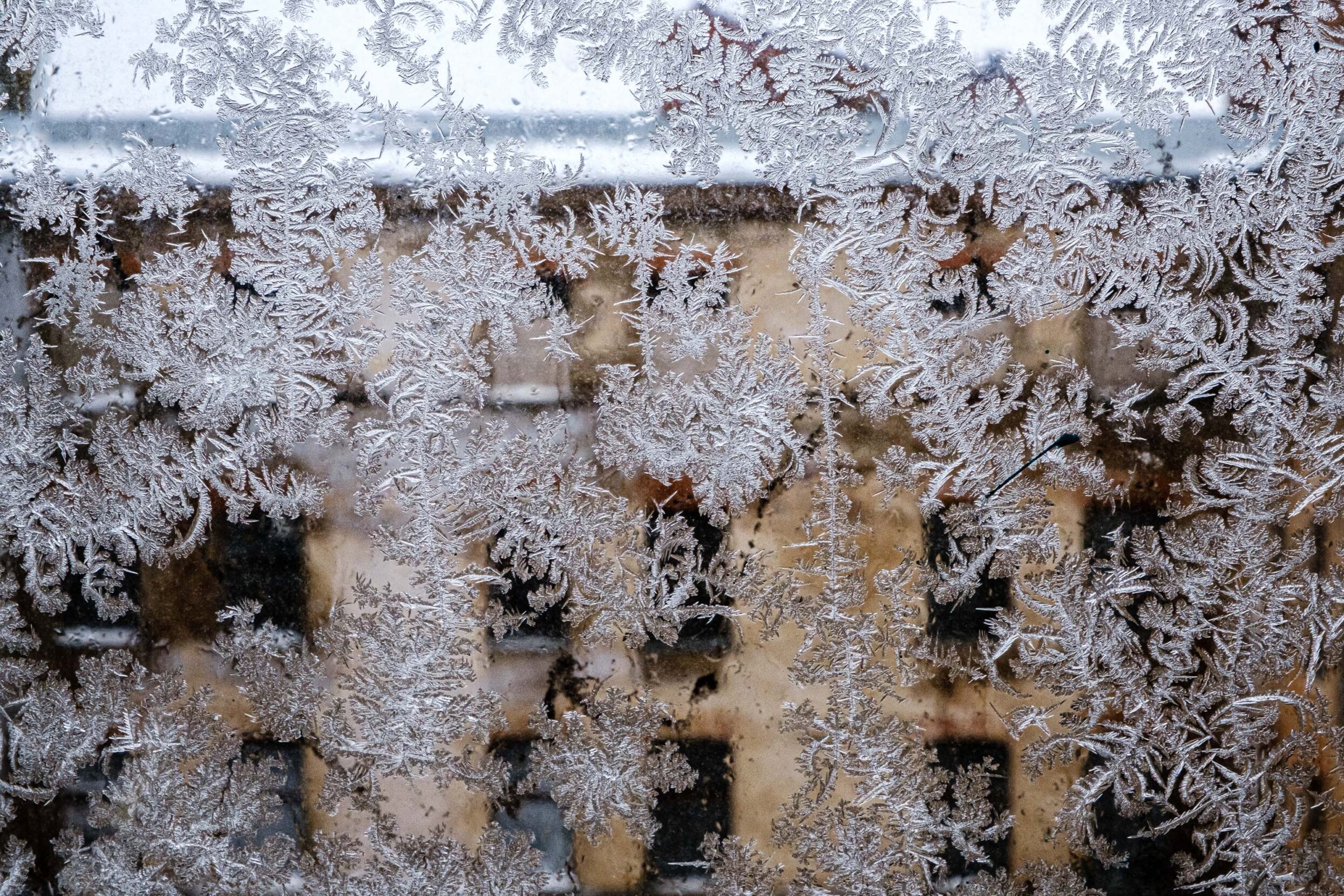
The delicate patterns of hoarfrost coat a window with one of the factory buildings in the distance. Photo: Tim Bird.
~~
Ten months later, I’m back for my third visit, this time in the company of Diana Bjorkland, an official from the local tourist authority. She is young, bright, and speaks excellent English. Her brother Denis, the interpreter, will join us later. Diana takes me down to a basement where continuously shifting LED colors illuminate a single silent loom, and eerie lighting dangles from the ceiling — art installations that perform their quiet show to a vacant chamber.
In another darkened hall, dim daylight permeates textile squares placed over the windows, resembling stained glass in a church. Each square represents a different design from Kreenholm’s portfolio. It seems a shame that these works are displayed, for the most part, to murmuring pigeons and silent shadows.
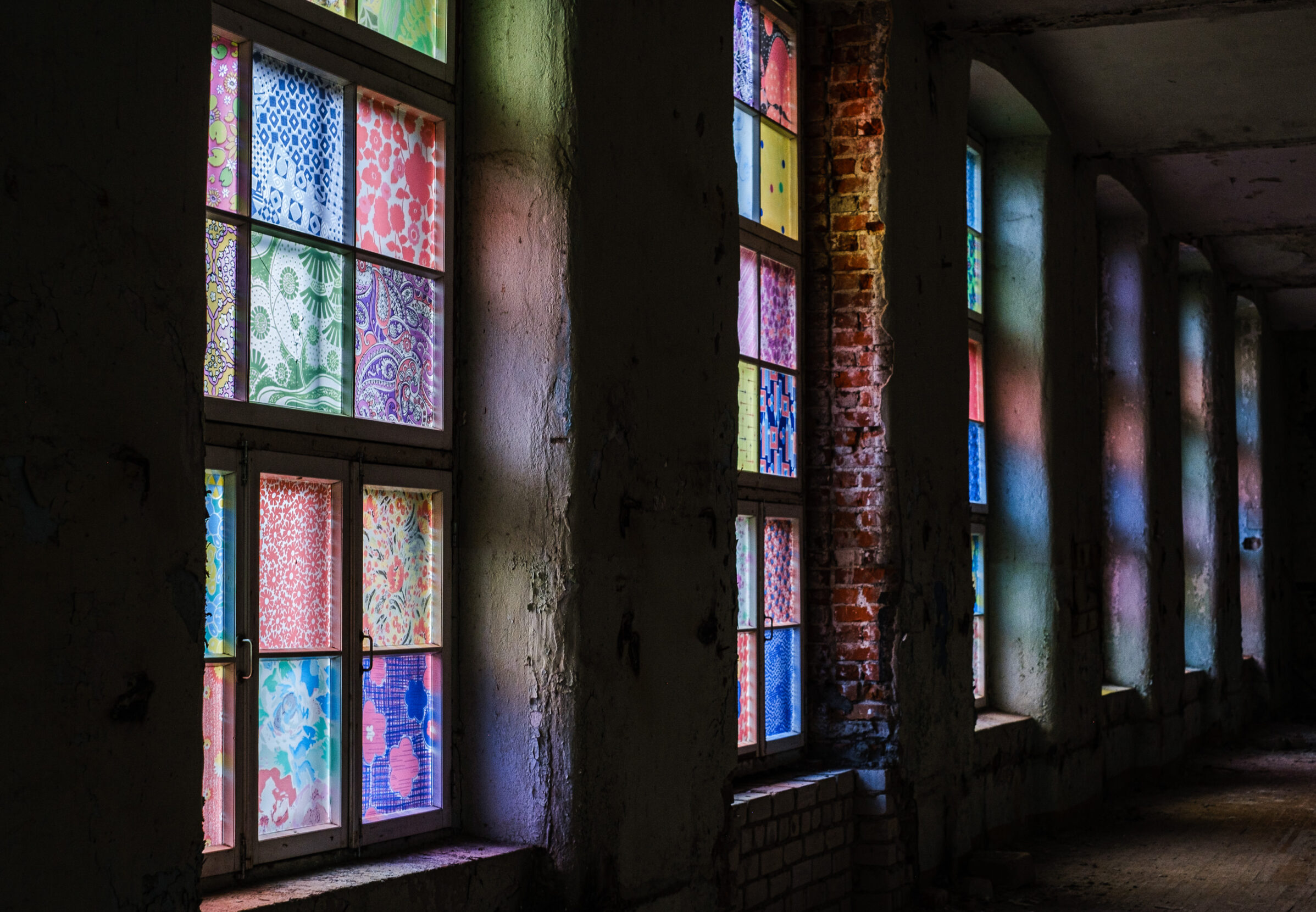
Textile squares affixed to window panes create a stained glass effect that displays some of the many designs produced at the factory, which once employed some 12,000 people. Photo: Tim Bird.
As we emerge into the brighter light of a more elevated hall, we’re stopped in our tracks by a sudden, soaring, ominous siren from across the river. I anticipate rushing back to the basement to shelter from an airborne attack.
“They’re releasing the water from the reservoir into the river,” Diana reassures me.
The alarm will let fishermen or anybody close to the river know that a cascade is imminent. This event occurs only a few times a year. We head out to one of the bridges across the rapids to watch the water foam and tumble, angry and loud, underneath.
“My stepfather fishes in the river. He says the fish are so confused by the faster flow when they open the weirs that you can catch them in your arms,” says Diana.
Later, two floors up, we settle in one of the most ornate and bright halls, preparing to greet two former workers. Ivo Loid was employed in the factory’s logistics section, and Olga Tyurina was an artist in the finishing factory — she is also a contributor to the church-like installation we visited earlier. Ivo’s first language is Estonian, Olga’s is Russian, and both are still Narva residents.
We can hear the gushing of the water from the river at the back of the building. Ivo tells us it reminds him of the noise in the factory when it was operating, so loud you couldn’t hear yourself speak, he says, waving his arms, eyes wide with excitement.
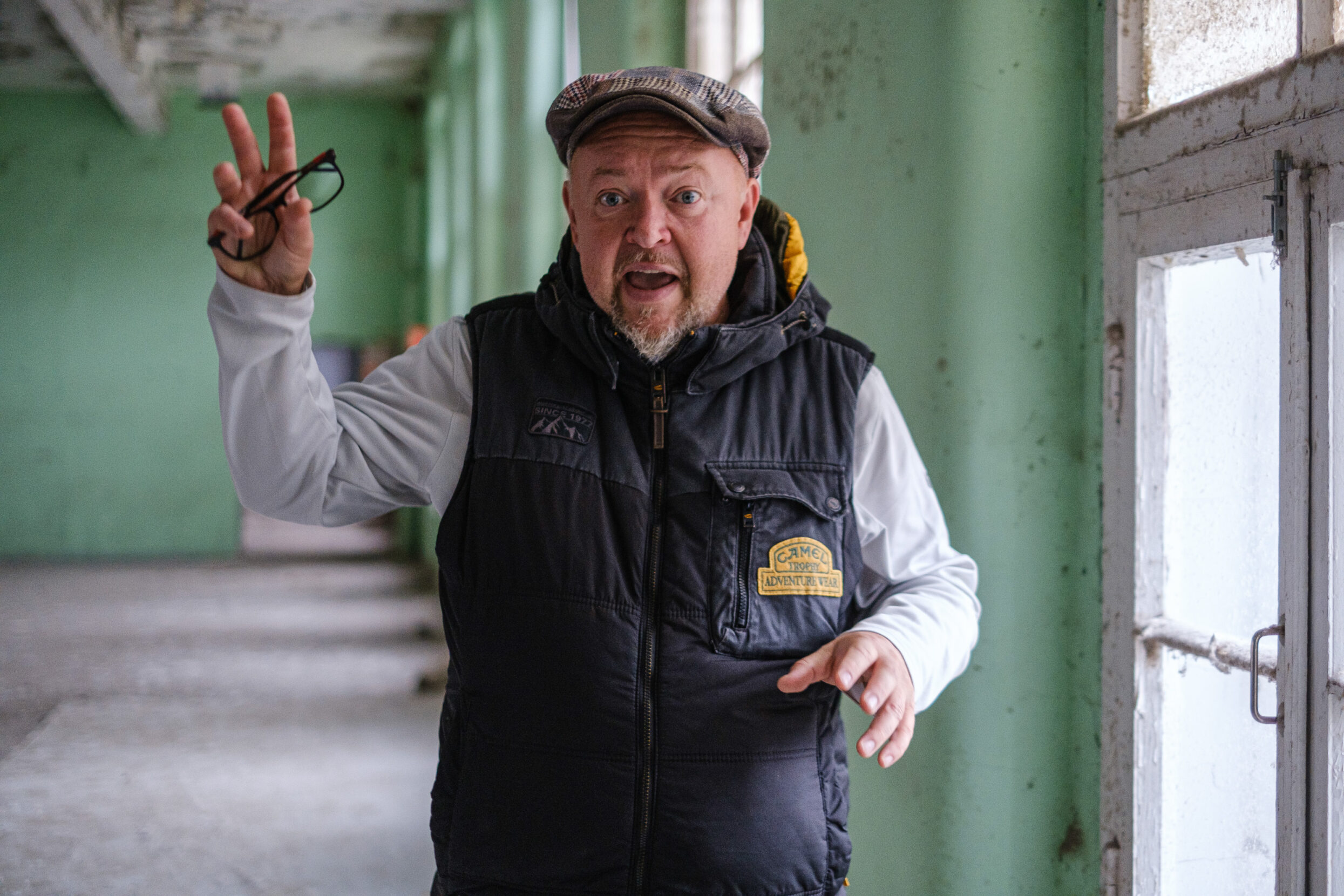
An animated Ivo Loid recounts the hustle and bustle of the working factory. Photo: Tim Bird.
Olga’s family arrived in Narva as nomads when Olga was four. “They were textile workers who moved around the Soviet Union,” she says. Over several decades, the movement of workers throughout the Soviet Union changed the makeup of Narva from a town that was two-thirds ethnic Estonian to one that was predominantly Russian-speaking. “My father was one of the specialists sent here to help create the finishing factory,” Olga adds.
Olga worked first in the clothing factory and later as a textile artist. “The workshops were full of machinery. It was noisy, clattering, with threads and fluff floating in the air. It really felt like something enormous, and at the same time, a very complex and challenging production. My first impression was also that there were many women. They wore polka-dot aprons and headscarves, and they spoke loudly, shouting over the noise of the workshop … I always had the feeling that Kreenholm was like a family.”
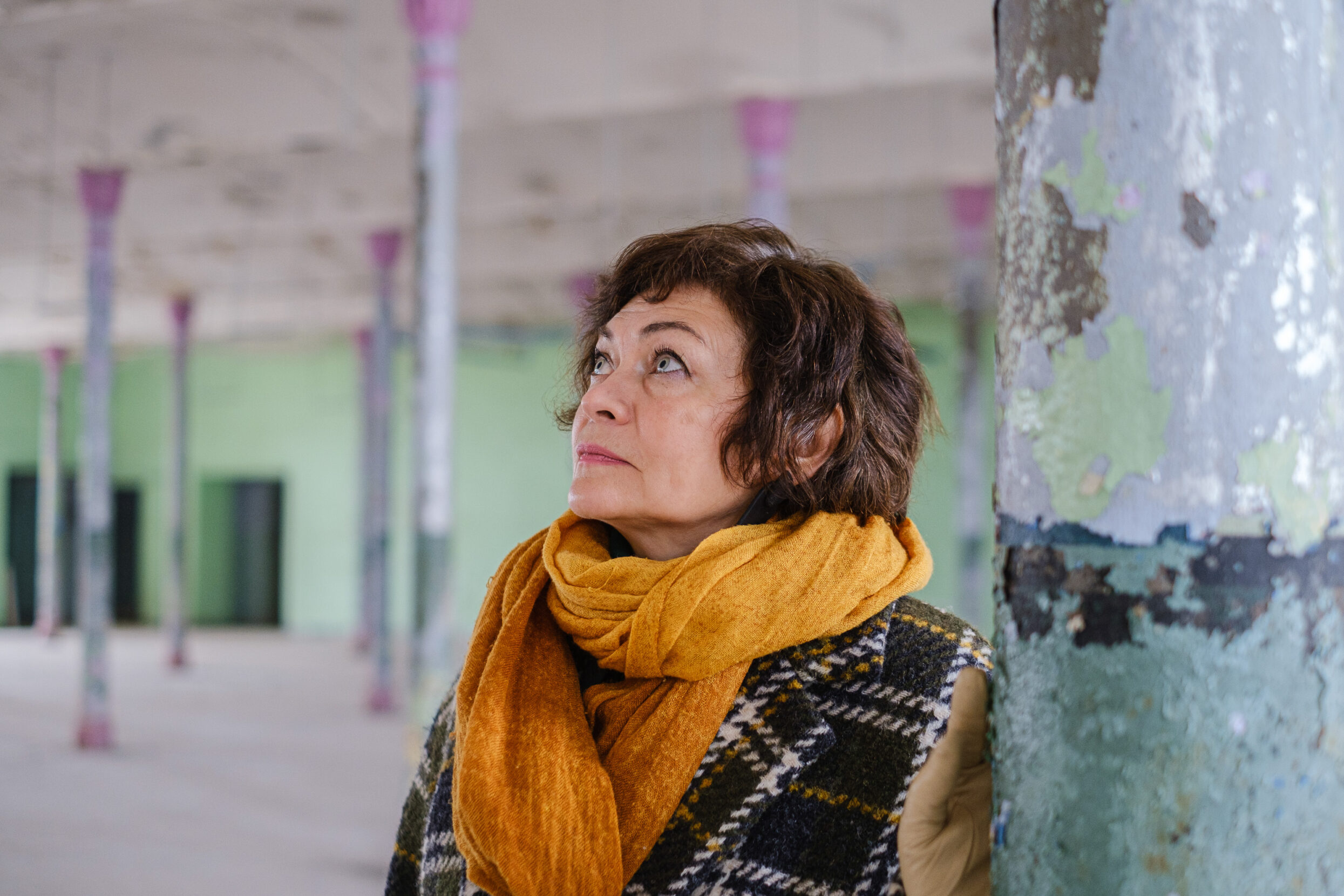
For textile artist Olga Tyurina, Kreenholm was more than just a place of work. Photo: Tim Bird.
~~
It’s early December 2024 when I pay my fourth visit and talk to Natalia. She is the last of my meetings with former employees. I’ve taken the train again from Tallinn, with its medieval fairy-tale old town and busy passenger harbor. Festive illuminations brighten Narva’s streets now, when the sun can hardly be bothered to raise its head above the horizon.
Tensions in this part of Europe have only increased since my last visit. Trans-Baltic power and internet cables between Finland and Estonia are being damaged with suspicious regularity. Although I haven’t seen it myself, I’ve been reading reports in international media that the Russians have been flying a blimp airship — a giant inflated balloon resembling a fat white cigar — on an almost weekly basis close to the border near Narva. The airship bears the letter Z, the symbol of the Russian war in Ukraine. Presumably, they are doing this to wind up the Estonians, to jangle their nerves, and even goad them into reacting. If the latter were to happen, Russia could “justify” an incursion or other response.
Her anguish at attending the now cavernous, deserted shell is palpable.
Natalia shifts a little in her chair in the former administrators’ canteen, with its wooden paneling and pop art wall. Initially reticent and anxious, she has warmed to our conversation, although her voice still cracks when she describes the sadness of Kreenholm’s demise and the tensions across the border.
“It’s all very sad,” she says, “because when the Swedes bought Kreenholm in 1993, the first people they fired were the artists … There used to be 12,000 workers at Kreenholm, and all of them ended up outside its gates. Gradually, but eventually, everyone was let go. That’s why it’s so heartbreaking, and even being here at the factory now feels sorrowful because the building stands lifeless, like a dead structure.”
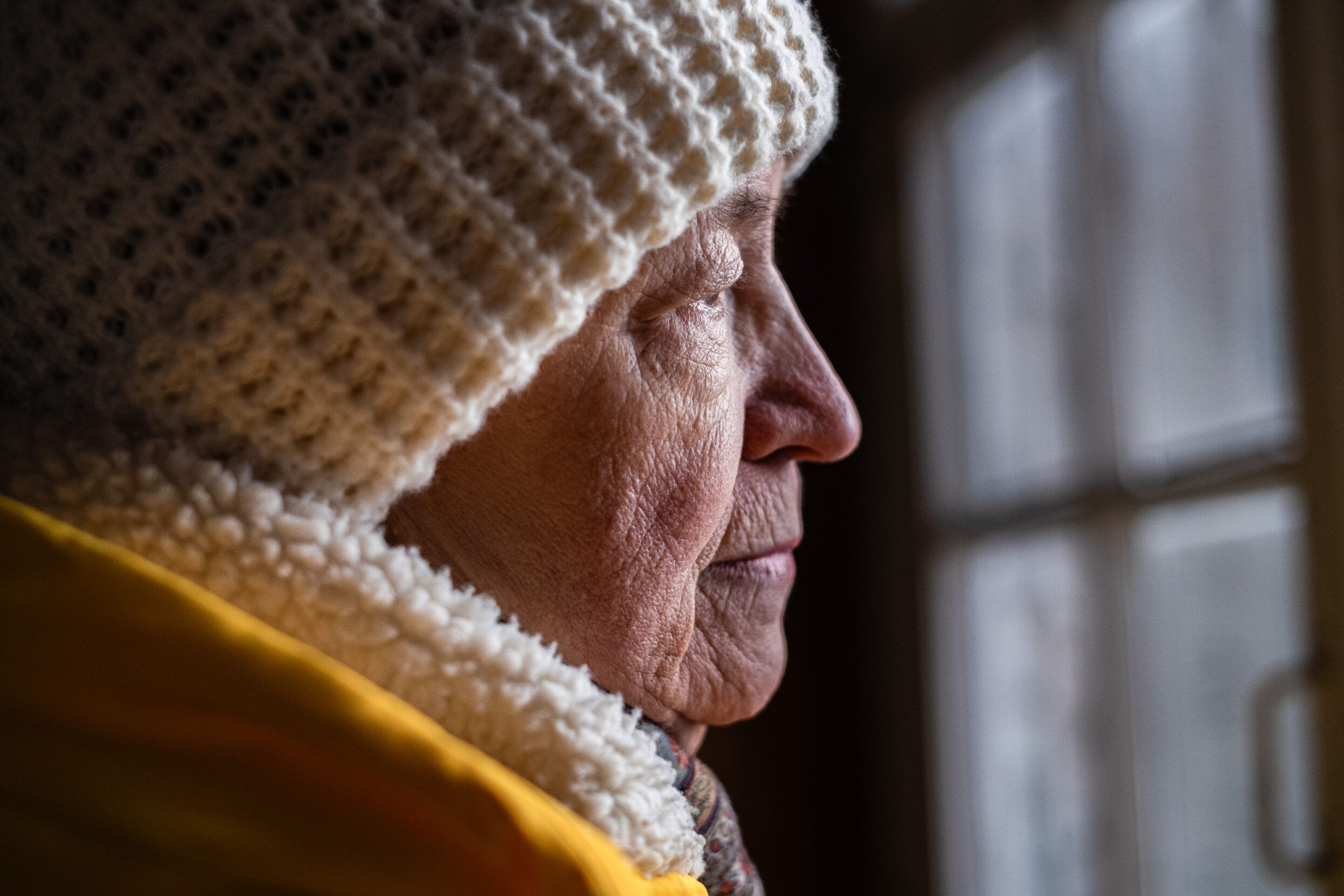
For Narva residents and former Kreenholm employees like Natalia Kapaeva, the decline of Kreenholm feels like a personal tragedy — one amplified by an uncertain future. Photo: Tim Bird.
Through the cracked window and splintered frames, we can see a light sleet falling, and I shiver instinctively. We are near the end of our interview and I ask Denis to make it clear that Natalia doesn’t have to comment on my final question if it’s too sensitive. I ask her about the renewed tensions and events across the border. She pauses thoughtfully, then continues, a slight tremble in her voice.
“It’s heartbreaking and terrifying, what is happening today. Yes, I have relatives — my sister, her children, and grandchildren — and friends there, on the other side of the border. And in Ukraine as well. It’s painful, deeply painful. I do what I can to help Ukrainians who live here. At the same time, it’s also painful to talk to friends and relatives who remain in Russia. I really hope this will end someday — God willing, the sooner, the better.”
With families divided on either side of the border, another layer in the troubled and bewildering fabric of the region is being woven.
~~
The next afternoon I take the train back through darkened villages to the brighter lights of Tallinn, my camera’s memory cards bursting with images, and my notebook bulging with thoughts.
I consider Natalia’s hopes for a future of peaceful reconciliation, both for the tensions at the border and Kreenholm’s fate. Her sentiments echo those of the other Narva residents I have spoken to.
“Narva has always been a trading crossroads,” she told me. “It’s a pity that many young people are leaving. Of course, these are economic issues, but some do return — bringing back knowledge and experience — and work to make our city even better so that all of us can live well here. Although there are plans to revive Kreenholm as an artistic or cultural site, it all depends on money and time, I suppose. We’ll have to wait and hope that something good will eventually come of it.”
Beneath the city lights of Tallinn, Kreenholm stays with me. Created as an industrial powerhouse under Russian rule, some of the happiest memories of Kreenholm’s former workers paradoxically are also from an era of occupying empire. Too huge to demolish, too costly to develop, any possibility of its revival seems a long way off. But today, ordinary citizens on both sides of the frontier, emphasized by those two opposing and imposing castles, continue to go about their daily lives. Kreenholm feels like the symbol of a complex, restless history — the latest traumatic phase of which is still unfolding.
Tim Bird
Starting each day with the intention, not always successful in seizing it, Tim Bird is always looking for creative ways to deal with the fact that he gets bored easily.

